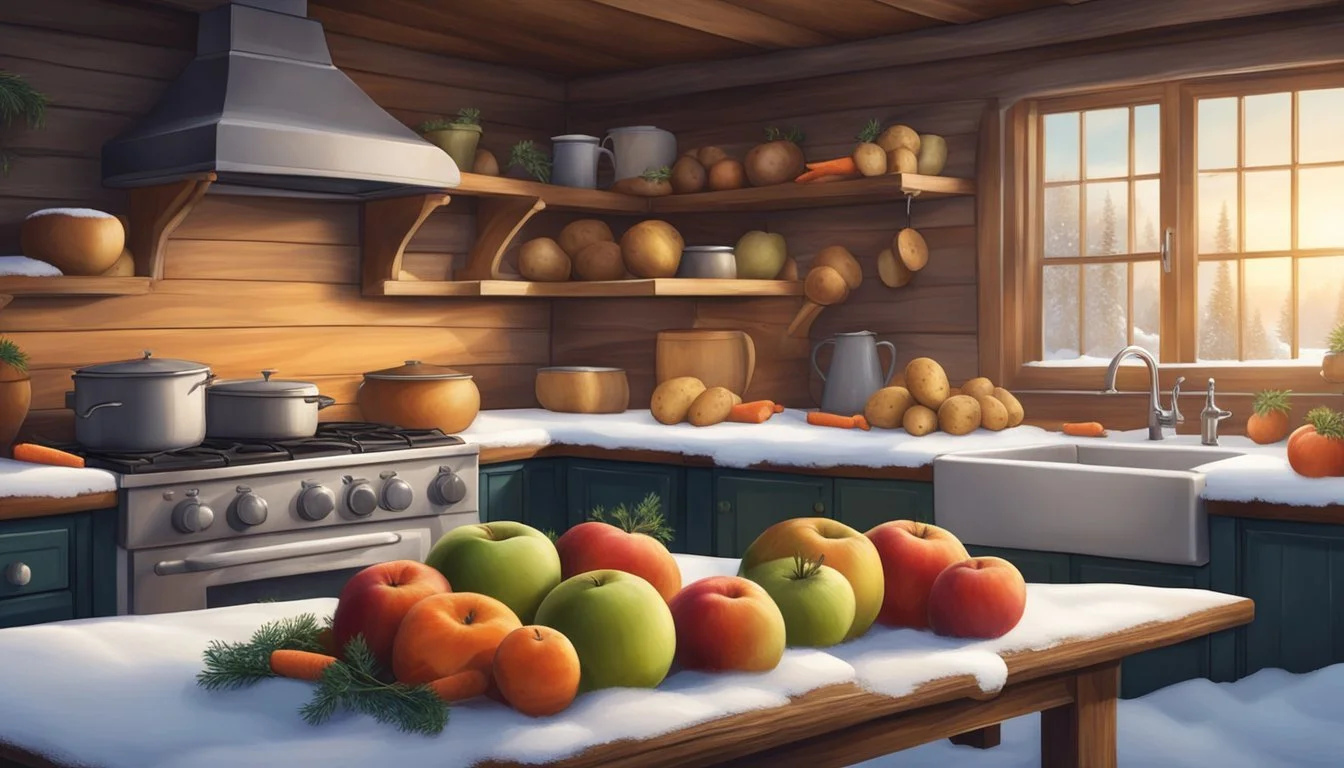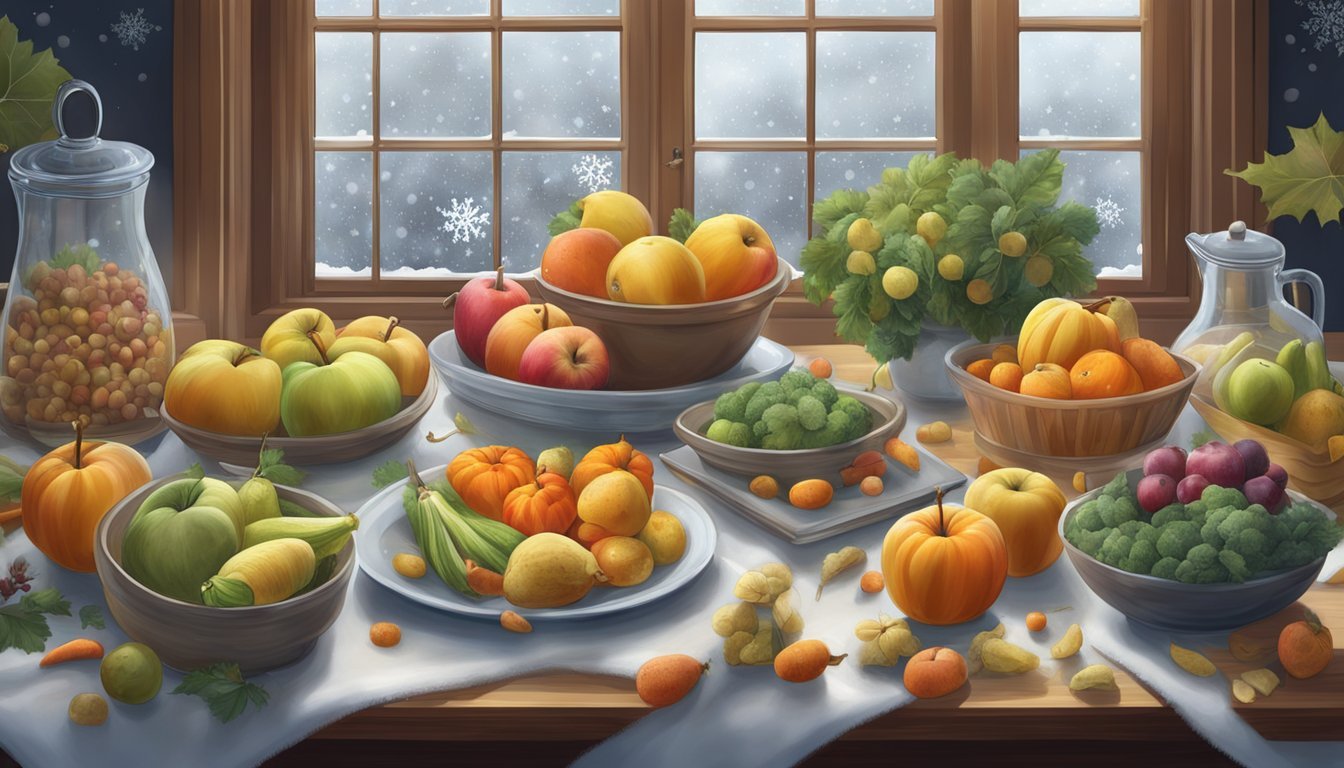North Dakota Seasonal Fruit & Vegetables in December
Your Winter Produce Guide
This Article is Part of our North Dakota Seasonal Fruit & Veg Calendar
December in North Dakota is characterized by its cold and frosty climate, a stark contrast to the warm, fruitful bounty of summer months. While many associate this time of the year with limited fresh produce, there are still fruits and vegetables that thrive during the early winter season, or are available due to successful storage techniques from earlier harvests. This period sees North Dakota offering a selection of hardy root vegetables and some fruits that can withstand the chilly temperatures.
Root vegetables such as carrots (how long do carrots last?) and brussels sprouts (how long do brussels sprouts last?) are staples during December, benefitting from the cooler temperatures that often result in a sweeter taste after a frost. Storage crops like cabbage and cauliflower also remain available during this month, having been harvested in the fall and kept in conditions to maintain their freshness. In terms of fruit, while the variety is less abundant than in summer, cranberries are often a highlight owing to their fall harvest and availability through early winter.
Access to these seasonal offerings allows for nutritious and flavorful ingredients that cater to the desire for hearty and warming winter meals. Not only does incorporation of these fruits and vegetables into December diets in North Dakota support local agriculture, but it also ensures that even during the coldest months, residents can enjoy produce at its peak freshness and nutritional value.
Overview of North Dakota's Seasonal Produce
In December, North Dakota's growers adapt to the restrictive cold climate to provide seasonal produce. Understanding both the local hardiness zones and farming techniques during winter is crucial to appreciating the region's agricultural output during this time.
Understanding Hardiness Zones
North Dakota sits predominantly in USDA Hardiness Zones 3b through 4b, which means the winter temperatures can dip to a frigid range of -35 to -25°F. These conditions severely shorten the outdoor growing season and influence the types of vegetables that can survive. In general, root vegetables and cold-hardy greens have better resistance to lower temperatures, hence are more commonly available from local producers during winter months.
Winter Season Agricultural Practices
Farmers in North Dakota employ various practices to extend the growing seasons, such as the use of greenhouses, hoop houses, and cold frames. These structures help protect plants from harsh winter conditions, allowing for the production of some fresh produce. Despite the challenges, local farms may still supply items like Brussels sprouts, spinach, and kale, which are robust enough to grow in cooler climates and can often be harvested into December.
Winter Fruits and Vegetables Available in December
In December, North Dakota's agricultural output adapts to the cold, offering a variety of robust vegetables that can withstand frosty conditions. This month is rich with root vegetables, hearty greens, winter squash, and a range of cruciferous vegetables.
Root Vegetables and Tubers
Root vegetables and tubers thrive in North Dakota's December chill. Notable for their storage capability and sweetness enhanced by the cold, here's what shoppers can find:
Potatoes: A staple in many cuisines, versatile in cooking.
Sweet Potatoes: Rich in flavor and nutrients, they are an excellent addition to winter meals.
Carrots: Known for their crisp texture and sweetness.
Parsnips: Similar to carrots but with a nuttier flavor, parsnips are often used in soups and stews.
Hearty Greens
While many greens might shy away from the cold, some brave the winter offering refreshing crispness:
Kale: With leaves that become sweeter after a frost, kale is ideal for salads and cooking.
Cabbage: A cold-hardy vegetable that's perfect for fermenting or cooking.
Winter Squash Varieties
Winter squash, with its thick skin, makes it a perfect candidate for storage through the cold months. December brings several varieties to the table:
Acorn Squash: Sweet, nutty, and versatile for baking or stuffing.
Butternut Squash: (how long does butternut squash last?) Smooth and creamy, excellent for soups and purees.
Cruciferous Vegetables
This family of vegetables is known for their health benefits and ability to withstand cooler temperatures. They remain in good supply during December:
Broccoli: Ideal for a range of culinary uses, from raw salads to hearty soups.
Brussels Sprouts: When roasted, they develop a delicious, caramelized outer layer.
Cauliflower: It's as versatile as it is nutritious and can be found fresh in December.
Preparation and Cooking Methods for December Produce
In December, North Dakota's seasonal produce offers a variety of flavors and textures suitable for different preparation and cooking methods. From storage techniques to enhance shelf life to roasting that brings out natural sweetness, these methods elevate the taste and nutritional benefits of the produce.
Storage and Preservation
Seasonal produce such as root vegetables and hardy greens can be kept for longer periods when stored properly. Root vegetables like beets and carrots should be kept in a cool, dark place, preferably in a cellar or a refrigerator. Leafy greens, on the other hand, maintain their freshness when wrapped in damp paper towels and refrigerated in airtight containers.
Roasting Techniques
Roasted vegetables become pleasantly sweet and develop a warm, caramelized flavor that is ideal for winter meals. To roast, one should:
Preheat the oven to 425°F (220°C).
Chop vegetables into uniform pieces for even cooking.
Toss them lightly with olive oil, salt, and preferred seasonings.
Spread them single-layered on a baking sheet.
Roast until they are tender and display a rich color, usually around 25-30 minutes for vegetables like carrots and Brussels sprouts.
Creating Winter Soups and Stews
Soups and stews are quintessential winter comfort foods. They start with a base of sautéed onions and garlic to release their flavors, followed by adding seasonal produce and letting them simmer to meld. December vegetables such as kale and root vegetables contribute a heartiness to these dishes. Seasoning should be adjusted to taste, with options like thyme and rosemary complementing the mild and earthy flavors of the produce.
Recipes and Flavor Pairings
December produce in North Dakota stands out in recipes that pair their natural flavors with suitable counterparts:
Roasted beets pair well with tangy goat cheese and are enhanced by herbs like dill (how long does dill last?)or mint.
Kale can be softened and combined with cranberries and nuts for a flavorful salad.
A blend of roasted carrots and parsnips creates a sweet and savory side dish that complements robust meats.
For a dessert, roasted squash can be pureed and spiced with cinnamon and nutmeg (how long does nutmeg last?) for a warm, sweet finish.
Health Benefits of Seasonal Consumption
Consuming seasonal produce, especially during the harsh North Dakota winters, allows individuals to benefit from higher nutrient content and the freshness associated with recently harvested crops. These practices align with healthier lifestyle choices and support local agriculture.
Nutrient Density of Winter Crops
Winter crops in North Dakota are esteemed for their nutrient density, which refers to the concentration of essential vitamins and minerals. Root vegetables such as carrots and potatoes, which are hearty winter options, are packed with vitamins A and C, potassium, and fiber. These nutrients are crucial for maintaining good health, supporting immune function, and aiding digestion. Because these vegetables are able to withstand colder temperatures, they can be harvested closer to the time of consumption, which helps to preserve their nutritional value.
Cruciferous vegetables like cabbage and Brussels sprouts thrive in cooler weather and are available in the winter months. They are rich in vitamin K, folate, and antioxidants. Antioxidants are important as they combat free radicals in the body, reducing oxidative stress and potentially lowering the risk of chronic diseases.
Impact of Eating In-Season Produce
Consuming in-season produce also offers an impact that extends beyond individual health benefits. When people choose in-season produce, they are often purchasing the freshest available options. Freshly harvested fruits and vegetables, such as winter squash, have had less time to lose their nutritional potency as opposed to those stored for long periods or transported over long distances.
Moreover, by eating in-season, consumers support local farmers and contribute to a more sustainable food economy. It can also lead to more diverse dietary habits as individuals explore different types of produce available at various times of the year. This variety is not only beneficial for the local ecosystem but also for the gut microbiome, as it ensures a wider range of nutrients and fibers.
North Dakota's December Fruit and Vegetable Availability
In December, the state of North Dakota experiences winter conditions that can be challenging for agriculture. However, consumers can still access a variety of locally grown fruits and vegetables. With the limited availability due to the cold climate, focus shifts to storage crops and greenhouse-grown produce.
Root Vegetables: Hearty root vegetables are staples during this time. Options include:
Beets
Carrots
Potatoes
Turnips
These vegetables are typically harvested before the heavy frosts and stored for winter use.
Squashes and Pumpkins: Winter squashes and pumpkins, known for their long shelf-life, are often available. Varieties like butternut, acorn, and spaghetti squash can be found in North Dakota during December.
Greenhouse Produce: Some producers extend their growing season with the use of greenhouses, providing fresh greens such as:
Lettuce
Spinach
Apples and Pears: While the peak season for apples and pears is in the fall, stored varieties can still be accessible in December, offering a sweet contrast to the more savory winter selections.
Preserved Goods: Locally made products from earlier harvests are often available. These include items such as:
Jams
Pickles
Salsas
Due to the harsh winters, fresh, locally grown fruits are scarce. However, the aforementioned produce remains available, emphasizing North Dakota’s capability to provide despite the season's limitations. Residents often rely on these winter-hardy options for both nutrition and seasonal culinary traditions.
Local Markets and Agriculture Data
In North Dakota during December, the impact of seasonal changes is evident in the local markets and agricultural data. These markets adapt to the winter months and the agricultural community shifts its focus from harvest to planning for the next season.
Farming Communities and Local Markets
North Dakota's farming communities play a vital role in supporting local markets, even during the cold winter month of December. While most fresh produce is scarce, some farmers markets remain operational, often selling goods like preserves and root vegetables that store well through winter. The North Dakota Farmers Market & Growers Association provides a network for these markets, ensuring that even in winter, communities have access to local agricultural products.
Agriculture Production Statistics
Agricultural production data is critical for understanding the state's economy and informing future farming practices. Despite the downturn in farming activity during December, the North Dakota Department of Agriculture continues to track statistics, such as livestock numbers and grain storage levels, to aid in assessing year-end performance and planning for the forthcoming planting season.
Farmers Market Calendar
The farmers market calendar in North Dakota adjusts according to the season. While many markets reduce their operations in December, some extend the season with holiday-themed events, providing opportunities to purchase value-added products like jams, syrups, and crafts. The calendar serves as a guide for consumers looking to support local agriculture during the off-season.








